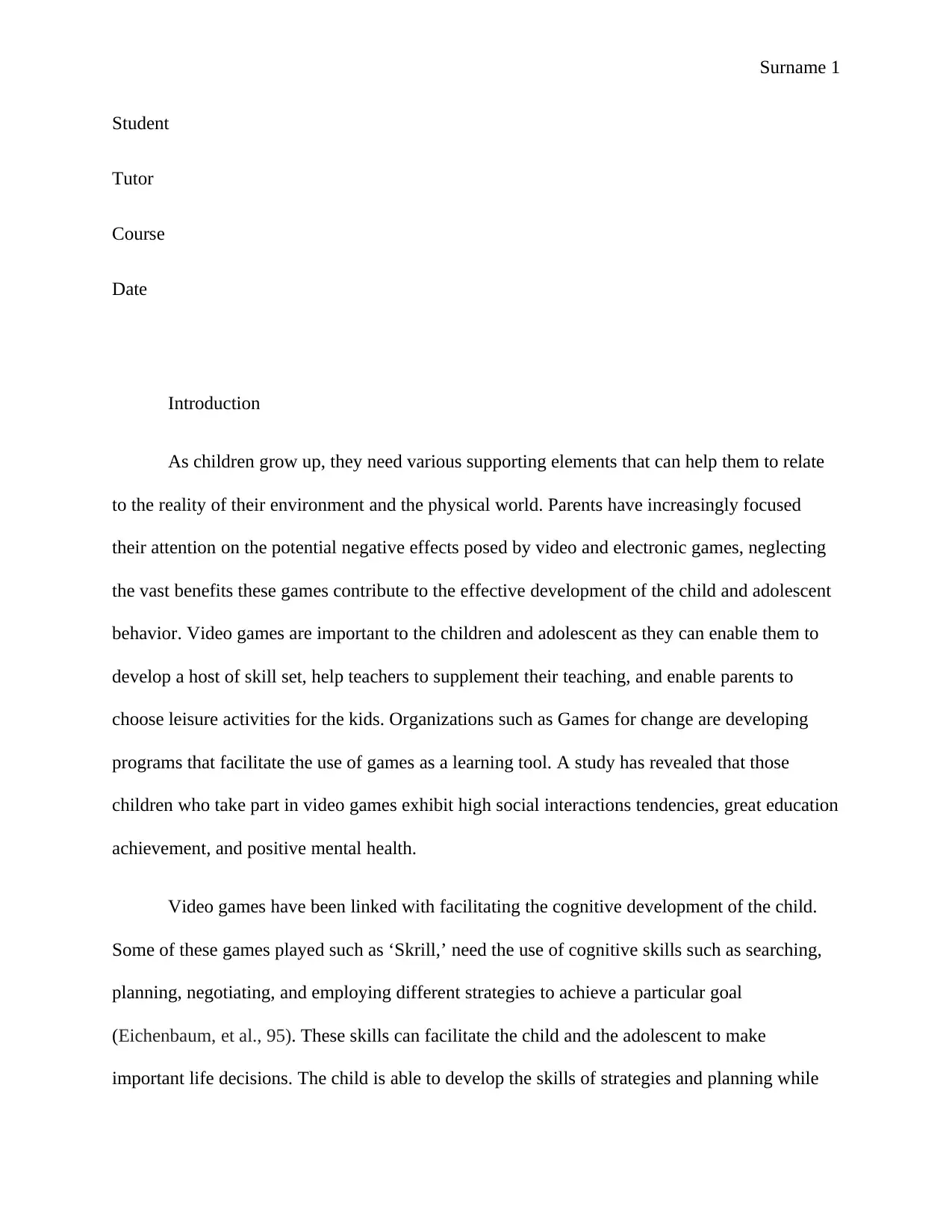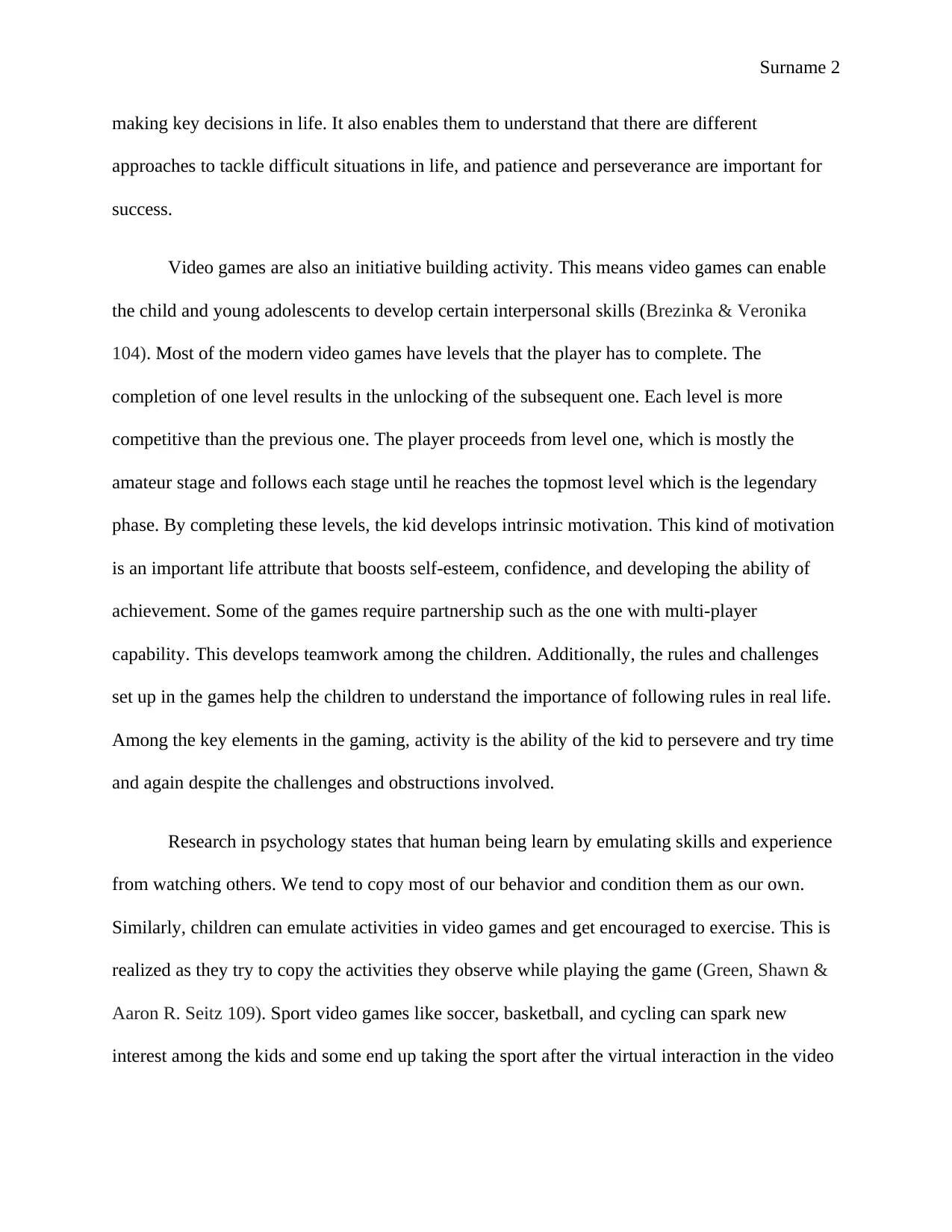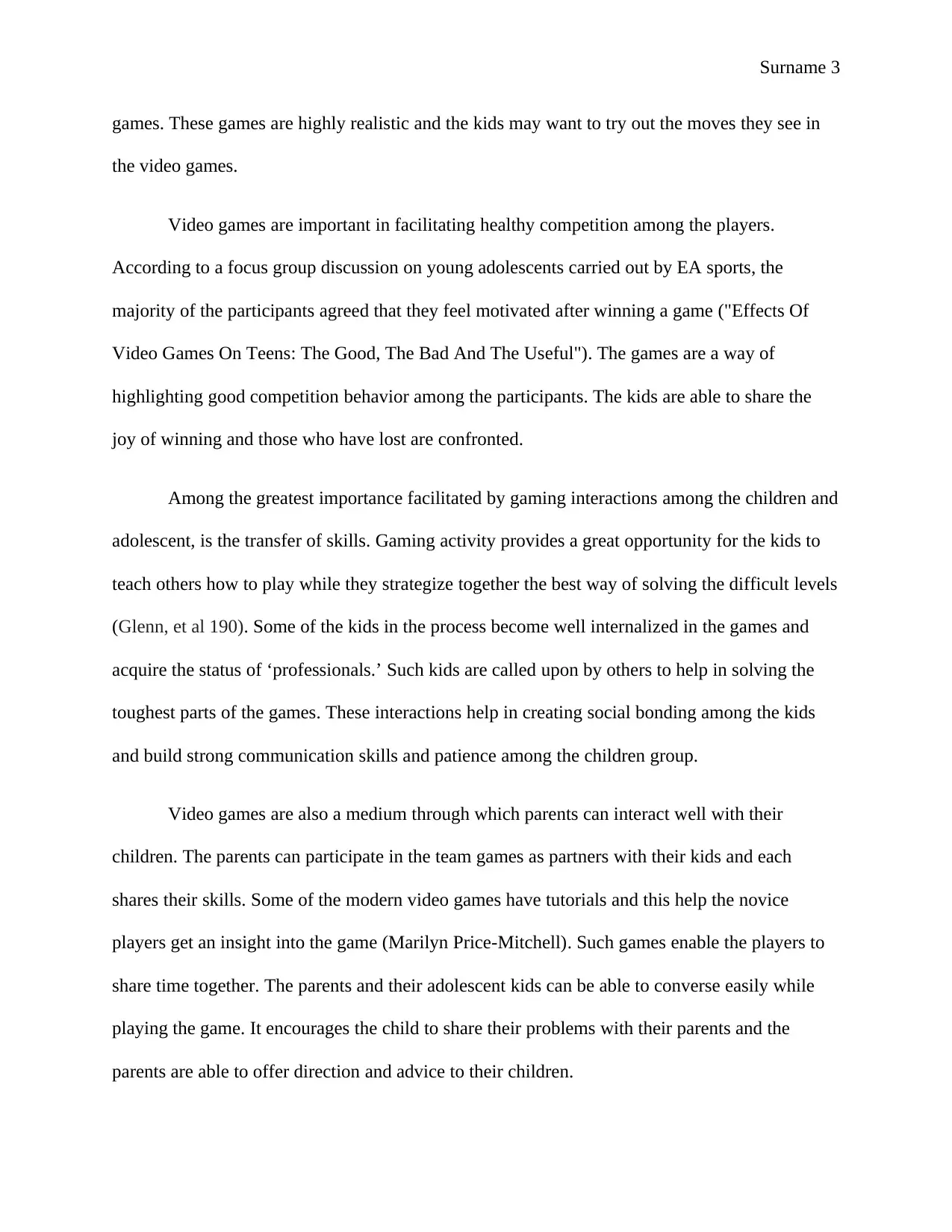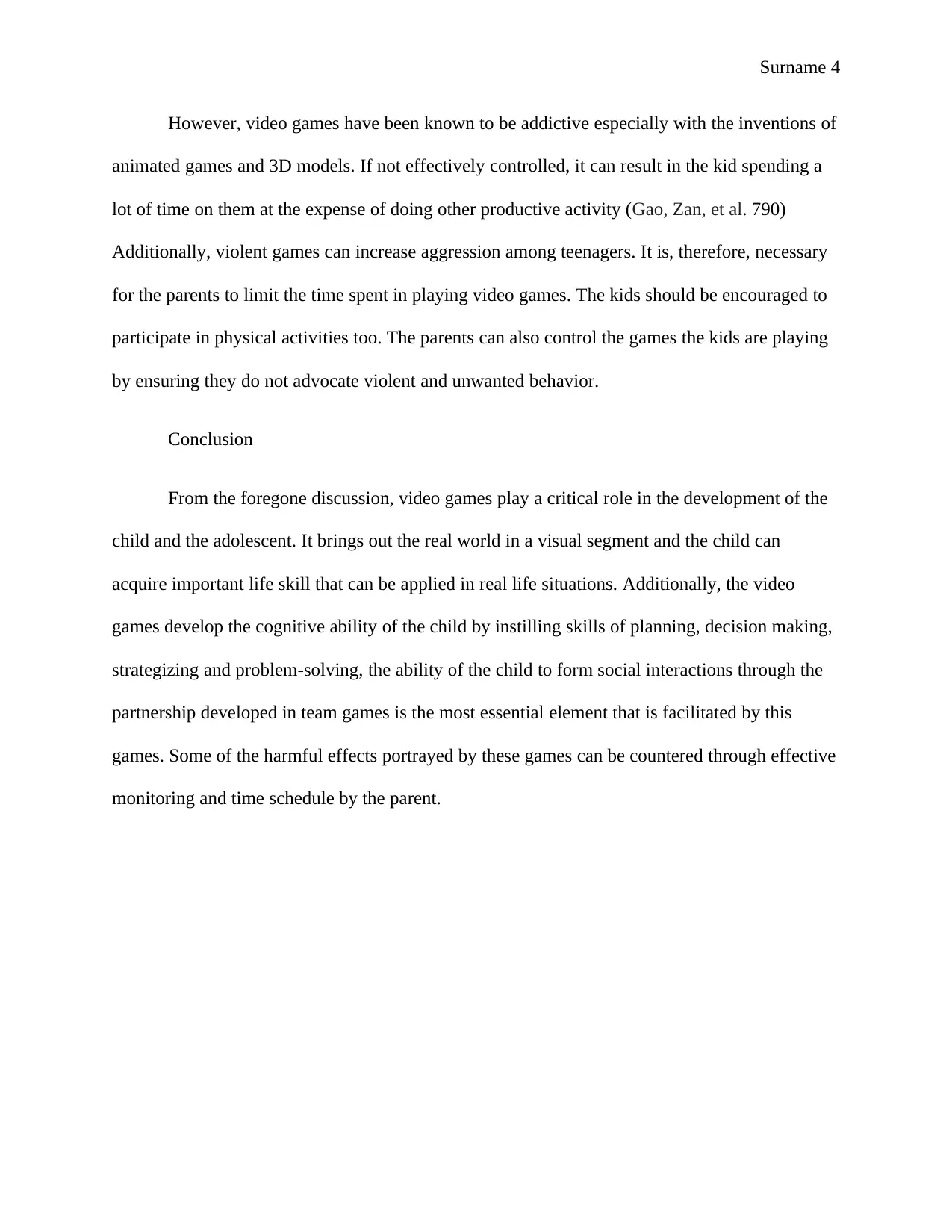Video Games: Cognitive, Social, and Physical Benefits for Children
VerifiedAdded on 2023/01/03
|5
|1444
|71
Essay
AI Summary
This essay explores the multifaceted impact of video games on child and adolescent development. It highlights the cognitive benefits, such as improved strategic thinking, planning, and decision-making skills, and the development of social skills through teamwork and interaction. The essay also discusses the physical benefits of video games, such as the encouragement of physical activities through sports video games. It emphasizes the role of parents in monitoring and managing the time spent on video games to mitigate potential negative effects like addiction and aggression. The essay uses research to support the argument that video games can foster cognitive development, social interaction, and a range of skills applicable to real-life situations, ultimately contributing to a child's overall growth and well-being. The essay also addresses the importance of balancing video game usage with other activities and emphasizes the significance of parental guidance in ensuring a healthy and balanced approach to gaming.

Surname 1
Student
Tutor
Course
Date
Introduction
As children grow up, they need various supporting elements that can help them to relate
to the reality of their environment and the physical world. Parents have increasingly focused
their attention on the potential negative effects posed by video and electronic games, neglecting
the vast benefits these games contribute to the effective development of the child and adolescent
behavior. Video games are important to the children and adolescent as they can enable them to
develop a host of skill set, help teachers to supplement their teaching, and enable parents to
choose leisure activities for the kids. Organizations such as Games for change are developing
programs that facilitate the use of games as a learning tool. A study has revealed that those
children who take part in video games exhibit high social interactions tendencies, great education
achievement, and positive mental health.
Video games have been linked with facilitating the cognitive development of the child.
Some of these games played such as ‘Skrill,’ need the use of cognitive skills such as searching,
planning, negotiating, and employing different strategies to achieve a particular goal
(Eichenbaum, et al., 95). These skills can facilitate the child and the adolescent to make
important life decisions. The child is able to develop the skills of strategies and planning while
Student
Tutor
Course
Date
Introduction
As children grow up, they need various supporting elements that can help them to relate
to the reality of their environment and the physical world. Parents have increasingly focused
their attention on the potential negative effects posed by video and electronic games, neglecting
the vast benefits these games contribute to the effective development of the child and adolescent
behavior. Video games are important to the children and adolescent as they can enable them to
develop a host of skill set, help teachers to supplement their teaching, and enable parents to
choose leisure activities for the kids. Organizations such as Games for change are developing
programs that facilitate the use of games as a learning tool. A study has revealed that those
children who take part in video games exhibit high social interactions tendencies, great education
achievement, and positive mental health.
Video games have been linked with facilitating the cognitive development of the child.
Some of these games played such as ‘Skrill,’ need the use of cognitive skills such as searching,
planning, negotiating, and employing different strategies to achieve a particular goal
(Eichenbaum, et al., 95). These skills can facilitate the child and the adolescent to make
important life decisions. The child is able to develop the skills of strategies and planning while
Paraphrase This Document
Need a fresh take? Get an instant paraphrase of this document with our AI Paraphraser

Surname 2
making key decisions in life. It also enables them to understand that there are different
approaches to tackle difficult situations in life, and patience and perseverance are important for
success.
Video games are also an initiative building activity. This means video games can enable
the child and young adolescents to develop certain interpersonal skills (Brezinka & Veronika
104). Most of the modern video games have levels that the player has to complete. The
completion of one level results in the unlocking of the subsequent one. Each level is more
competitive than the previous one. The player proceeds from level one, which is mostly the
amateur stage and follows each stage until he reaches the topmost level which is the legendary
phase. By completing these levels, the kid develops intrinsic motivation. This kind of motivation
is an important life attribute that boosts self-esteem, confidence, and developing the ability of
achievement. Some of the games require partnership such as the one with multi-player
capability. This develops teamwork among the children. Additionally, the rules and challenges
set up in the games help the children to understand the importance of following rules in real life.
Among the key elements in the gaming, activity is the ability of the kid to persevere and try time
and again despite the challenges and obstructions involved.
Research in psychology states that human being learn by emulating skills and experience
from watching others. We tend to copy most of our behavior and condition them as our own.
Similarly, children can emulate activities in video games and get encouraged to exercise. This is
realized as they try to copy the activities they observe while playing the game (Green, Shawn &
Aaron R. Seitz 109). Sport video games like soccer, basketball, and cycling can spark new
interest among the kids and some end up taking the sport after the virtual interaction in the video
making key decisions in life. It also enables them to understand that there are different
approaches to tackle difficult situations in life, and patience and perseverance are important for
success.
Video games are also an initiative building activity. This means video games can enable
the child and young adolescents to develop certain interpersonal skills (Brezinka & Veronika
104). Most of the modern video games have levels that the player has to complete. The
completion of one level results in the unlocking of the subsequent one. Each level is more
competitive than the previous one. The player proceeds from level one, which is mostly the
amateur stage and follows each stage until he reaches the topmost level which is the legendary
phase. By completing these levels, the kid develops intrinsic motivation. This kind of motivation
is an important life attribute that boosts self-esteem, confidence, and developing the ability of
achievement. Some of the games require partnership such as the one with multi-player
capability. This develops teamwork among the children. Additionally, the rules and challenges
set up in the games help the children to understand the importance of following rules in real life.
Among the key elements in the gaming, activity is the ability of the kid to persevere and try time
and again despite the challenges and obstructions involved.
Research in psychology states that human being learn by emulating skills and experience
from watching others. We tend to copy most of our behavior and condition them as our own.
Similarly, children can emulate activities in video games and get encouraged to exercise. This is
realized as they try to copy the activities they observe while playing the game (Green, Shawn &
Aaron R. Seitz 109). Sport video games like soccer, basketball, and cycling can spark new
interest among the kids and some end up taking the sport after the virtual interaction in the video

Surname 3
games. These games are highly realistic and the kids may want to try out the moves they see in
the video games.
Video games are important in facilitating healthy competition among the players.
According to a focus group discussion on young adolescents carried out by EA sports, the
majority of the participants agreed that they feel motivated after winning a game ("Effects Of
Video Games On Teens: The Good, The Bad And The Useful"). The games are a way of
highlighting good competition behavior among the participants. The kids are able to share the
joy of winning and those who have lost are confronted.
Among the greatest importance facilitated by gaming interactions among the children and
adolescent, is the transfer of skills. Gaming activity provides a great opportunity for the kids to
teach others how to play while they strategize together the best way of solving the difficult levels
(Glenn, et al 190). Some of the kids in the process become well internalized in the games and
acquire the status of ‘professionals.’ Such kids are called upon by others to help in solving the
toughest parts of the games. These interactions help in creating social bonding among the kids
and build strong communication skills and patience among the children group.
Video games are also a medium through which parents can interact well with their
children. The parents can participate in the team games as partners with their kids and each
shares their skills. Some of the modern video games have tutorials and this help the novice
players get an insight into the game (Marilyn Price-Mitchell). Such games enable the players to
share time together. The parents and their adolescent kids can be able to converse easily while
playing the game. It encourages the child to share their problems with their parents and the
parents are able to offer direction and advice to their children.
games. These games are highly realistic and the kids may want to try out the moves they see in
the video games.
Video games are important in facilitating healthy competition among the players.
According to a focus group discussion on young adolescents carried out by EA sports, the
majority of the participants agreed that they feel motivated after winning a game ("Effects Of
Video Games On Teens: The Good, The Bad And The Useful"). The games are a way of
highlighting good competition behavior among the participants. The kids are able to share the
joy of winning and those who have lost are confronted.
Among the greatest importance facilitated by gaming interactions among the children and
adolescent, is the transfer of skills. Gaming activity provides a great opportunity for the kids to
teach others how to play while they strategize together the best way of solving the difficult levels
(Glenn, et al 190). Some of the kids in the process become well internalized in the games and
acquire the status of ‘professionals.’ Such kids are called upon by others to help in solving the
toughest parts of the games. These interactions help in creating social bonding among the kids
and build strong communication skills and patience among the children group.
Video games are also a medium through which parents can interact well with their
children. The parents can participate in the team games as partners with their kids and each
shares their skills. Some of the modern video games have tutorials and this help the novice
players get an insight into the game (Marilyn Price-Mitchell). Such games enable the players to
share time together. The parents and their adolescent kids can be able to converse easily while
playing the game. It encourages the child to share their problems with their parents and the
parents are able to offer direction and advice to their children.
⊘ This is a preview!⊘
Do you want full access?
Subscribe today to unlock all pages.

Trusted by 1+ million students worldwide

Surname 4
However, video games have been known to be addictive especially with the inventions of
animated games and 3D models. If not effectively controlled, it can result in the kid spending a
lot of time on them at the expense of doing other productive activity (Gao, Zan, et al. 790)
Additionally, violent games can increase aggression among teenagers. It is, therefore, necessary
for the parents to limit the time spent in playing video games. The kids should be encouraged to
participate in physical activities too. The parents can also control the games the kids are playing
by ensuring they do not advocate violent and unwanted behavior.
Conclusion
From the foregone discussion, video games play a critical role in the development of the
child and the adolescent. It brings out the real world in a visual segment and the child can
acquire important life skill that can be applied in real life situations. Additionally, the video
games develop the cognitive ability of the child by instilling skills of planning, decision making,
strategizing and problem-solving, the ability of the child to form social interactions through the
partnership developed in team games is the most essential element that is facilitated by this
games. Some of the harmful effects portrayed by these games can be countered through effective
monitoring and time schedule by the parent.
However, video games have been known to be addictive especially with the inventions of
animated games and 3D models. If not effectively controlled, it can result in the kid spending a
lot of time on them at the expense of doing other productive activity (Gao, Zan, et al. 790)
Additionally, violent games can increase aggression among teenagers. It is, therefore, necessary
for the parents to limit the time spent in playing video games. The kids should be encouraged to
participate in physical activities too. The parents can also control the games the kids are playing
by ensuring they do not advocate violent and unwanted behavior.
Conclusion
From the foregone discussion, video games play a critical role in the development of the
child and the adolescent. It brings out the real world in a visual segment and the child can
acquire important life skill that can be applied in real life situations. Additionally, the video
games develop the cognitive ability of the child by instilling skills of planning, decision making,
strategizing and problem-solving, the ability of the child to form social interactions through the
partnership developed in team games is the most essential element that is facilitated by this
games. Some of the harmful effects portrayed by these games can be countered through effective
monitoring and time schedule by the parent.
Paraphrase This Document
Need a fresh take? Get an instant paraphrase of this document with our AI Paraphraser

Surname 5
Work cited
"Effects Of Video Games On Teens: The Good, The Bad And The Useful". Your Teen
Magazine, 2019, https://yourteenmag.com/technology/teens-video-games.
Brezinka, Veronika. "Computer games supporting cognitive behaviour therapy in
children." Clinical child psychology and psychiatry 19.1 (2014): 100-110.
Eichenbaum, Adam, Daphne Bavelier, and C. Shawn Green. "Video games: Play that can do
serious good." American Journal of Play 7.1 (2014): 50-72.
Gao, Zan, et al. "A meta‐analysis of active video games on health outcomes among children and
adolescents." Obesity reviews 16.9 (2015): 783-794.
Glenn, Nicole M., et al. "Meanings of play among children." Childhood 20.2 (2013): 185-199.
Granic, Isabela, Adam Lobel, and Rutger CME Engels. "The benefits of playing video
games." American psychologist 69.1 (2014): 66.
Green, C. Shawn, and Aaron R. Seitz. "The impacts of video games on cognition (and how the
government can guide the industry)." Policy Insights from the Behavioral and Brain
Sciences 2.1 (2015): 101-110.
Marilyn Price-Mitchell, PhD. "Effects Of Video Games: More Good Than Bad For Youth
Development? | Roots Of Action". Roots Of Action, 2019,
https://www.rootsofaction.com/video-games-for-kids-more-good-than-bad-for-
development/.
Work cited
"Effects Of Video Games On Teens: The Good, The Bad And The Useful". Your Teen
Magazine, 2019, https://yourteenmag.com/technology/teens-video-games.
Brezinka, Veronika. "Computer games supporting cognitive behaviour therapy in
children." Clinical child psychology and psychiatry 19.1 (2014): 100-110.
Eichenbaum, Adam, Daphne Bavelier, and C. Shawn Green. "Video games: Play that can do
serious good." American Journal of Play 7.1 (2014): 50-72.
Gao, Zan, et al. "A meta‐analysis of active video games on health outcomes among children and
adolescents." Obesity reviews 16.9 (2015): 783-794.
Glenn, Nicole M., et al. "Meanings of play among children." Childhood 20.2 (2013): 185-199.
Granic, Isabela, Adam Lobel, and Rutger CME Engels. "The benefits of playing video
games." American psychologist 69.1 (2014): 66.
Green, C. Shawn, and Aaron R. Seitz. "The impacts of video games on cognition (and how the
government can guide the industry)." Policy Insights from the Behavioral and Brain
Sciences 2.1 (2015): 101-110.
Marilyn Price-Mitchell, PhD. "Effects Of Video Games: More Good Than Bad For Youth
Development? | Roots Of Action". Roots Of Action, 2019,
https://www.rootsofaction.com/video-games-for-kids-more-good-than-bad-for-
development/.
1 out of 5
Related Documents
Your All-in-One AI-Powered Toolkit for Academic Success.
+13062052269
info@desklib.com
Available 24*7 on WhatsApp / Email
![[object Object]](/_next/static/media/star-bottom.7253800d.svg)
Unlock your academic potential
Copyright © 2020–2025 A2Z Services. All Rights Reserved. Developed and managed by ZUCOL.





